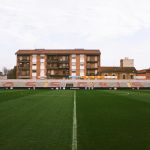
History and aesthetics of Vallecas
And because the fans of Rayo Vallecano do not want a new stadium
February 27th, 2024
There are teams that represent a city, others that represent a region, and others that represent a neighborhood. Rayo Vallecano belongs to the latter category: the neighborhood in question is Vallecas, a southeastern area of Madrid that until 1950 was an autonomous municipality before being annexed to the city of Madrid. And around these two points a dispute is developing between the Rayo fans and the club's president Raúl Martín Presa. Despite often being described as the third team in Madrid after Real and Atletico, Rayo is the team of Vallecas and the fans from Vallecas do not want to move. It is a necessary stance from their point of view after President Presa announced his intention to build a new stadium for Rayo, a new facility that would potentially be built far from the Vallecas neighborhood. This was confirmed by the President of the Community of Madrid, Isabel Díaz Ayuso, who highlighted that there are no suitable sites in Vallecas to host a new stadium.
Since 1976, Rayo Vallecano has played its home games at the Campo de Fútbol de Vallecas, a stadium that is literally located in the center of a residential district. This is not an exaggeration. It is the reason why behind one of the two goals, specifically on the north side of the stadium, there is not a stand but instead a huge advertising billboard. Behind it stand some apartment buildings that have become an integral part of the stadium, as it has become common to see windows adorned with flags or filled with fans on match day. It is a fascinating and unique stadium, but at the same time it is also small, outdated, and above all, not very profitable. It has a capacity of 14,000 seats, the second smallest in LaLiga after Montilivi, the home stadium of Girona. It is a stadium that generates little income, and for this reason President Presa wants to abandon it to build a new facility that would allow, at least in theory, to make more money and thus try to build a more competitive team. The point is that the Rayo fans are not convinced. They made it clear without mincing words during the home game against Real Madrid on February 18th, when they displayed signs that read: "Este es nuestro estadio, no nos moverán" ("This is our stadium, we will not be moved"). Rayo is the expression of the working-class community in the Vallecas neighborhood.
Read also
The group of Bukaneros, the organized fan group of Rayo, is one of the few ultra groups of the left. The band Ska-P, one of the most influential bands in the ska-punk scene, is from Vallecas and dedicated a song to Rayo. But the story that best represents the bond between Rayo and Vallecas dates back to 2014 when the club decided to come to the aid of Carmen Ayuso, an 84-year-old woman who was evicted from her home due to a debt contracted by her son. Rayo helped Ms. Ayuso find a new place to live, and even covered her rent for the rest of her life. In Vallecas, Rayo is not just a football team, it is a reference for the entire community that identifies with the white and red colors.
And these colors are also tied to a particular story that illustrates the relationship between the club and Madrid and its other two teams. Legend has it that in 1948, Atletico Madrid decided to help Rayo, which was struggling financially, by loaning some of its players in exchange for permission to use Rayo's sports facilities. The only clause in the agreement between the two clubs was that Rayo had to incorporate traces of red into their white uniforms at the time, so that they would be distinguished from those of Real Madrid. And it was on that occasion that the management decided to introduce a red diagonal stripe in the center of the uniform, known as la franja, as a tribute to River Plate, which today identifies Rayo Vallecano around the world. Starting from Vallecas and its stadium.








































.png)


.jpg)








